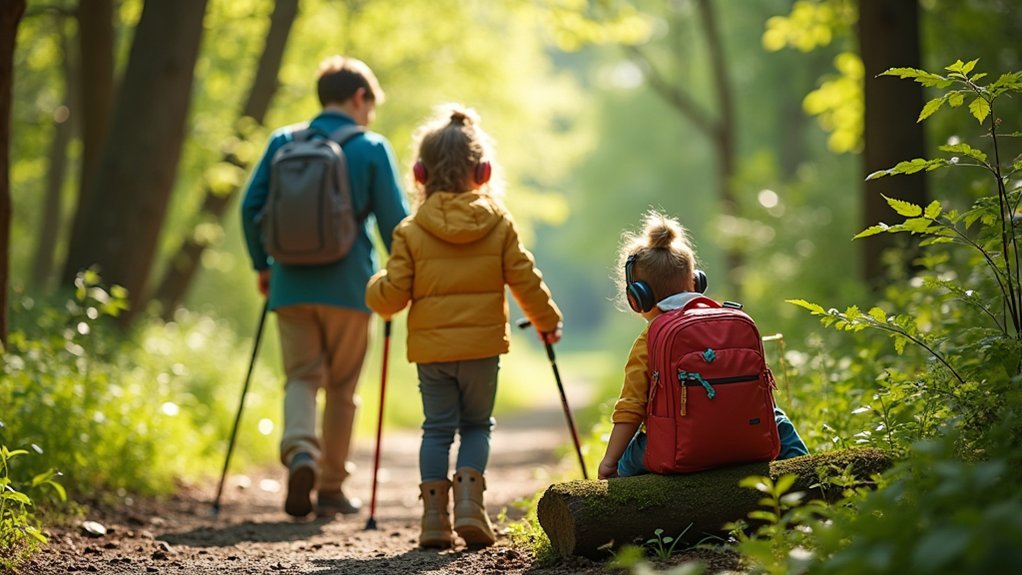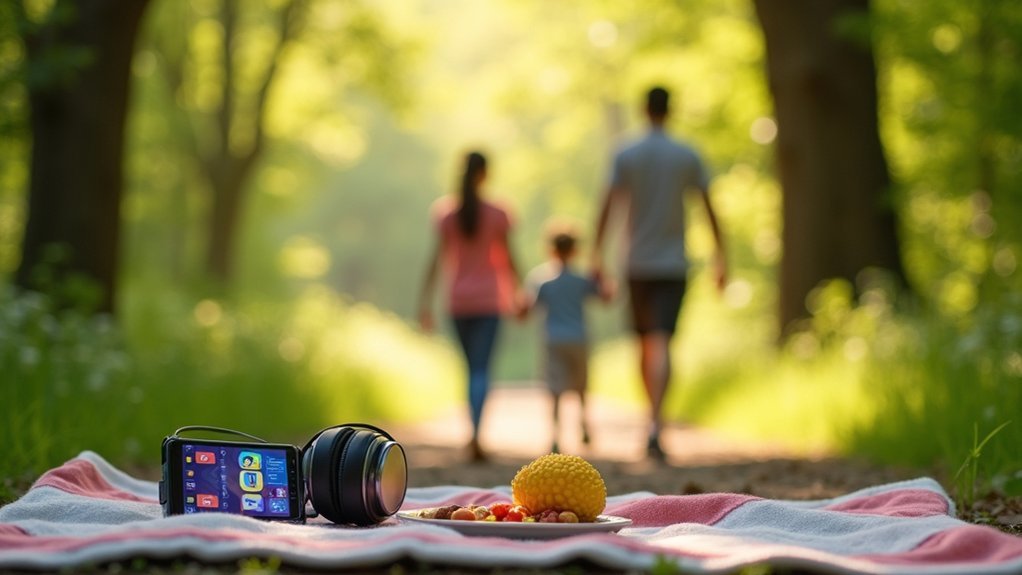Make outdoor adventures more accessible by equipping yourself with adaptive gear like noise-canceling headphones and soft clothing. Create predictable routines with visual schedules to ease shifts between activities. Establish clearly defined retreat zones where sensory overwhelm can be managed safely. Build tolerance through gradual exposure, starting with brief outings to familiar locations. Develop customized communication systems using visual supports and simple language for safety. These strategies will transform challenging outdoor experiences into enjoyable explorations for everyone involved.
Selecting Adaptive Gear for Sensory Regulation in Adventure Settings

When venturing outdoors with children who’ve sensory sensitivities, the right gear can transform a potentially overwhelming experience into an enjoyable adventure.
Start by investing in noise-canceling headphones to block jarring sounds that might trigger discomfort during outdoor activities.
Choose lightweight clothing made from soft, breathable fabrics without irritating tags or seams.
Don’t forget to pack sensory-friendly accessories like chewable necklaces or fidget toys that provide calming sensory and tactile input.
Sunglasses or wide-brimmed hats help reduce visual input from bright sunlight, preventing overstimulation.
For complete preparation, assemble a portable sensory kit containing stress balls, textured objects, and a soft blanket.
These familiar items create a comforting environment and help regulate anxiety, ensuring your child can fully participate in the natural wonders around them.
Creating Predictable Routines for Outdoor Transitions
Although spontaneity might work for some families, children with sensory sensitivities thrive on predictable routines during outdoor adventures.
Establish visual schedules that outline each step of your outdoor activities, helping your child understand what comes next and reduce anxiety about the unknown.
Incorporate familiar routines like consistent snack times during your outdoor adventure to create a sense of comfort and normalcy.
Using timers for changes between activities helps prepare your child for alterations while maintaining a predictable routine that addresses their sensory needs.
Discuss planned activities beforehand so your child can mentally adjust to the upcoming experience.
When you maintain consistency in your outdoor changes, you’ll build confidence that makes future adventures more successful and enjoyable for everyone involved.
Establishing Safe Retreat Zones During Activity Challenges

Creating designated safe retreat zones is essential for children with sensory sensitivities to fully enjoy outdoor adventures. Designate a specific area equipped with comfort items like blankets and favorite toys where your child can escape overwhelming stimuli.
Make sure this retreat zone is easily accessible and familiar, allowing your child to recognize it as their safe space during outdoor activities. Explain the purpose of this area beforehand, using visuals or social stories to reinforce understanding.
Your child’s safe retreat should be both accessible and recognizable, with proper preparation through visual supports to ensure complete understanding.
Watch for distress cues and encourage your child to use their retreat zone when needed, giving them control over managing their sensory experience.
Always incorporate this safe space into your outdoor plans, ensuring it remains consistently available during outings to effectively handle moments of sensory overload.
Building Sensory Tolerance Through Gradual Exposure
Building sensory tolerance represents a thoughtful journey rather than a sudden plunge into overwhelming experiences.
For children with autism spectrum, short, controlled outings help reduce stress while gradually introducing varied sensory input. Start with 15-minute visits to familiar outdoor locations, then slowly extend time as comfort grows.
Consistency creates predictability – revisit the same park or trail regularly before introducing new environments. Incorporate sensory-friendly activities like scavenger hunts or nature walks that engage with different textures, sounds, and sights at a manageable pace.
Remember to celebrate every achievement, no matter how small. Positive reinforcement encourages children to continue exploring sensory experiences on their terms.
This patient approach builds confidence and comfort over time, allowing your child to genuinely enjoy outdoor adventures while expanding their sensory tolerance naturally.
Customizing Communication Systems for Outdoor Safety

Effective communication forms the foundation of safe and successful outdoor experiences for children with sensory processing differences.
Create visual schedules and social stories specific to your planned adventure to help your child understand expectations and reduce anxiety about routine changes.
Use simple language paired with visual supports when explaining outdoor safety rules and emergency procedures.
Equip your child with picture cards or electronic devices that enable them to express discomfort or needs, promoting autonomy during activities.
Practice outdoor safety scenarios through role-playing before your adventure, helping your child develop communication skills they’ll need in real situations.
Consistently review your established communication system throughout the outing to guarantee your child maintains comfort and confidence in traversing new environments safely.
Frequently Asked Questions
How Do Weather Changes Affect Sensory Processing During Outdoor Activities?
Weather changes can overwhelm your senses. Temperature shifts, barometric pressure changes, wind, and increased humidity can make you feel irritable, anxious, or physically uncomfortable. You’ll need to adjust your plans accordingly.
When Should I Introduce Multiple Sensory Challenges Simultaneously?
You should introduce multiple sensory challenges only after individual sensations are well-tolerated. Start with familiar environments, gauge reactions, and don’t rush the process. Always respect personal thresholds and back off when you’re seeing discomfort.
How Can Siblings Support Sensory-Sensitive Children During Family Adventures?
Siblings can help by learning to recognize signs of sensory overload, offering quiet companionship, and respecting boundaries. You’ll strengthen family bonds when you encourage them to be patient and celebrate their sensitive sibling’s participation.
What Are Signs My Child Is Experiencing Sensory Overload Outdoors?
Your child might be experiencing sensory overload if they’re covering ears, squinting, becoming irritable, withdrawing, or having meltdowns. They’ll often seek escape or comfort, and their behavior may suddenly change during outdoor activities.
How Do Sensory Needs Change as Children Grow Older?
Your child’s sensory needs evolve with age. They’ll often become more aware of their triggers, develop coping strategies, and may experience changing sensitivities. Some challenges diminish while others might emerge during developmental shifts.
In Summary
With these five strategies, you’ll transform outdoor adventures from overwhelming to empowering for sensory-sensitive individuals. Remember to prioritize adaptation over avoidance—each small success builds confidence for future explorations. By thoughtfully preparing sensory-friendly gear, routines, spaces, and communication systems, you’re not just accommodating differences; you’re creating opportunities for everyone to discover their own meaningful connection with nature.





Leave a Reply